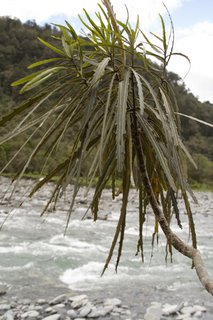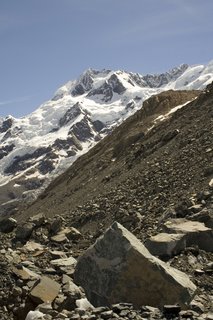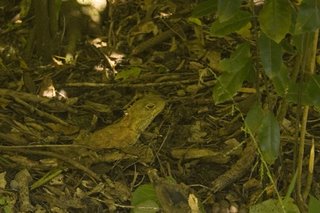
The weekend after New Year's we headed out on another cabin trip, but this one involved a sauna and colder temperatures. Most people left on Friday and came back on Sunday. I wasn't feeling too good on Thursday, so I decided not to go. (Admittedly, I wasn't all that excited about skiing 11 miles at -20 to -30 F (-30 to -35 C).) I felt better all day Friday, and I wasn't too happy about people having fun without me, so I packed up my things and got ready to head out on Saturday. I got an early start, started skiing at 10:00 am (before the sunrise) and made it into the cabin by 1:00 pm, just as they were finishing breakfast/brunch/lunch - it was a lazy morning for them.
The "group" consisted of 1 snowmobiler ("snowmachiner" in the Alaskan dialect), 4 skiiers (1 on tele-skis, 1 on randonee, and 2 on cross-country), 4 snowshoers, and 4 walkers/sledders, and 2 dogs. I'm usually not too keen on having snowmobiles around, but in this case it was a good thing. It was nice to have the security of knowing that if somebody got dangerously cold skiing/snowshoeing/hiking, that we could get them to the cabin quite quickly. We also got to bring with some things that you wouldn't bring without a snowmobile, like milk, juice, and a keg of beer.
Saturday afternoon was spent chatting and eating, in the evening we went for a dip in the hot springs. All 13 of us.
We got up relatively early Sunday morning and headed back to the trailhead - staggering everybody's start time so that we would all finish the journey at about the same time. We arrived in the early afternoon and started up the cars - or tried to. Three of them started no problem, one needed to be jumped and heated up with camping stove, and the fifth car just wouldn't start. We left it there and returned the next day with a generator and heater and a new battery - that did the trick.

Self-portrait after skiing 11 miles in frigid temperatures.

Inari after snowshoeing 11 miles.
It turned out that Saturday was the nicest day of the weekend, and so I felt glad that I chose to wait until then to ski in. The light was beautiful and there was no wind, a rare thing on that trail. It took me three hours to ski to the cabin, but it probably would've been quicker if I hadn't stopped to take so many photos.

Dr. Seuss's inspiration?

Spectacular light on Saturday morning.






















